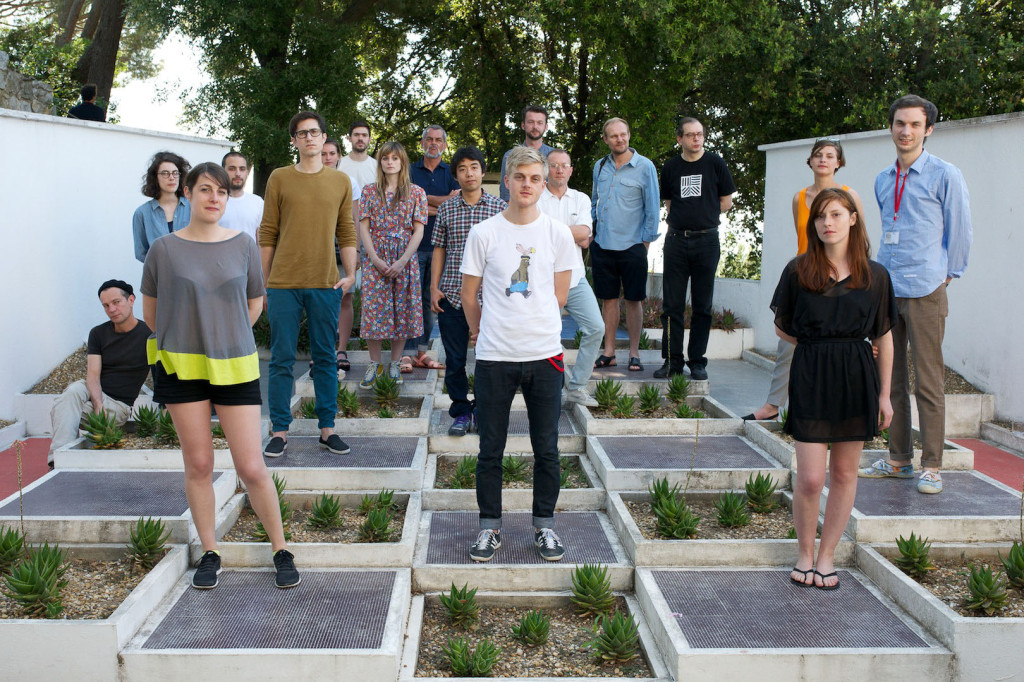Scouting great design in southern France
Design Parade!
-
Photo © Kevin Mertens for L'AB/Pamono
-
The Villa Noailles
Photo © Kevin Mertens for L'AB/Pamono
-
Photo © Kevin Mertens for L'AB/Pamono
-
Hyères, France
Photo © Kevin Mertens for L'AB/Pamono
-
Tricks & Flicks by Bertjan Pot
Photo © Kevin Mertens for L'AB/Pamono
-
Photo © Kevin Mertens for L'AB/Pamono
-
Tricks & Flicks by Bertjan Pot
Photo © Kevin Mertens for L'AB/Pamono
-
Tricks & Flicks by Bertjan Pot
Photo © Kevin Mertens for L'AB/Pamono
-
Tricks & Flicks by Bertjan Pot
Photo © Kevin Mertens for L'AB/Pamono
-
Tricks & Flicks by Bertjan Pot
Photo © Kevin Mertens for L'AB/Pamono
-
Les Vases Oreilles by Julie Richoz
Photo © Kevin Mertens for L'AB/Pamono
-
Dyade Lamp by Julie Richoz
Photo © Kevin Mertens for L'AB/Pamono
-
Marcel Breuer exhibition
Photo © Kevin Mertens for L'AB/Pamono
-
Bijoux Domestique by India Mahdavi - Eric Benqué
Photo © Kevin Mertens for L'AB/Pamono
-
Bijoux Domestique by India Mahdavi
Photo © Kevin Mertens for L'AB/Pamono
-
Director Jean-Pierre Blanc holding opening-speech
Photo © Kevin Mertens for L'AB/Pamono
-
Triangle cubist garden by Gabriel Guevrekian
Photo © Kevin Mertens for L'AB/Pamono
-
Mugi Yamamoto
Photo © Kevin Mertens for L'AB/Pamono
-
Gravity by Mugi Yamamoto
Photo © Kevin Mertens for L'AB/Pamono
-
Laureline Galliot
Photo © Kevin Mertens for L'AB/Pamono
-
Rhainbow Shades by Julien Renault
Photo © Kevin Mertens for L'AB/Pamono
-
Mathieu Peyroulet Ghilini
Photo © Kevin Mertens for L'AB/Pamono
-
Photo © Kevin Mertens for L'AB/Pamono
-
Photo © Kevin Mertens for L'AB/Pamono
-
Dimitri Bähler
Photo © Kevin Mertens for L'AB/Pamono
-
<em>© Kevin Mertens for L'AB/Pamono</em>
-
Photo © Kevin Mertens for L'AB/Pamono
-
L'ArcoBaleno girls
Photo © Kevin Mertens for L'AB/Pamono
-
Photo © Kevin Mertens for L'AB/Pamono
On a July morning, our in-house photographer, Kevin Mertens, and I left Berlin for Hyères, a small town near Toulon in the French Riviera. We were on our way to check out the annual design festival there—the Design Parade—which had been recommended to me by some of the gallerists we work with, like of Berlin and Didier Krzentowski of Paris. They praised the Design Parade and its Design Prix for young designers as a great opportunity to discover emerging talent, not to mention an all-around charming destination for a weekend getaway. My role here is to help source the very special objects available through the website, so I hoped my trip to Hyères would generate some exciting leads. I was not disappointed!
Hyères is undeniably beautiful. As we approached by car, we admired the tapestry of red-tiled roofs and low hills gently rolling toward the Mediterranean. The village’s narrow, medieval-style streets posed a navigational challenge, but once we parked, the picturesque vistas took our breath away. Given the town’s beauty, it’s no surprise that in the 18th century English aristocrats loved to holiday in Hyères—long before Monte Carlo became the hotspot.
That evening, meandering through a maze of centuries-old buildings lined with vibrant bougainvillea, we climbed up from the town center to the Villa Noailles, the grand, historic residence and lively art space that hosts the Design Parade’s exhibitions and events. While attending the opening cocktail party, sipping champagne on a terrace overlooking the sea, we learned that the illustrious French architect Robert Mallet-Stevens designed and built the villa between 1924 and 1932 for avant-garde art patrons Count and Countess Charles and Marie-Laure de Noailles. The Noailles were the “it” couple of their day, famous for supporting radical creative endeavors from the likes of Jean Cocteau, Salvador Dalí, Man Ray, Luis Buñuel, Jean-Michel Frank, and Charlotte Perriand, to name just a few.
Not long after the Countess passed away in 1970, the village of Hyères bought the villa, but it subsequently remained dormant for decades. In 1996, an association formed to reconnect Villa Noailles to contemporary visual culture. Overseen by director Jean Pierre Blanc and curator Stéphane Boudin-Lestienne, the villa now supports a permanent collection, artist residences, public workshops, and a year-round exhibition schedule dedicated to cutting-edge art, in addition to the now eight-year-old Design Parade every July.
After the opening speeches, we were allowed to enter the many exhibition spaces dispersed throughout the villa and its grounds. One of my favorites was an installation designed and curated by interior architect India Mahdavi. Each year, the Design Parade invites a noted figure from the design world to select a series of contemporary design works centered on a particular theme. This year, the honor went to Mahdavi, who presented Bijoux Domestique, an assemblage of jewelry-like furniture and home décor created by contemporary designers working in gold and filigree forms. Taher Chemerik’s Bijoux du Table was on view, along with Lindsey Adelman’s Catch Floor Light and Arik Levy’s sculpture series Solid Liquid. Of course, Mahdavi also included the exquisite tables and vases from her new Landscape Series, available for sale in our shop.
Another highlight was an exhibition by rising design star Julie Richoz. Born in France and educated at the acclaimed Swiss design school ECAL, Richoz participated in and won last year’s Design Parade Grand Prix, which led to residencies at Cité de la Céramique de Sèvres and at Centre International de Recherche sur le Verre et les Arts Plastiques de Marseille. In addition, Paris-based Galerie Kreo presented Richoz with a €5,000 research grant to develop a new design. Her exhibition at Villa Noailles unveiled the results of these three special projects: the Nelumbo Collection of bowls and cups, the Vases Oreilles, and the Dyade Lamp. Every object was more beautiful than the last!
In the former squash court and poolroom of the villa, I encountered Tricks & Flicks, a survey of work by Dutch designer Bertjan Pot. With a studio that is only 15 years old, Pot has earned an international reputation for surprising, often humorous designs—from his 1999 Random Light for Moooi, to the more recent Disco Dish and Downstairs lights for Den Herder Production House (DHPH). While Pot held a serious position at this year’s Design Parade as President of the Grand Prix Jury, his presentation retained his usual sense of light-heartedness and was a lot of fun to see.
The Design Parade offerings spanned the last century: a highly researched exhibition of work by modernist master Marcel Breuer; an engaging presentation of the Noailles’ life as art patrons; and installations by contemporary talents, both established—like Aldo Bakker—and up-and-coming—like Julien Renault.
The next afternoon, we returned to Villa Noailles to view the results of the Grand Prix. More than 250 young designers apply for this juried prize each year, from which ten are invited to produce new prototypes and exhibit during the Design Parade. Tasked with coaching the ten young designers through the prototyping process, this year’s jury included, in addition to Pot: designer Nipa Doshi of Doshi Levien; design critic Pierre Doze; Rolf Hay of Hay Edition; designer Max Lamb; Laurent Le Bon, Director of Centre Pompidou Metz; designer Leon Ransmeier; art director Giulio Ridolfo; and last year’s winner, Richoz.
The Grand Prix projects were displayed against the backdrop of the extravaganza of geometry that is the villa’s garden, originally designed in the 1920s by Cubist architect Gabriel Guevrekian. The setting was outstanding, and the prototypes provided some fascinating insights into new directions in design. Here is the rundown:
- Armoires by Sylvain Aebischer – hardware-less wardrobes exploiting a new material called Hylite, which is rigid or flexible, depending on the thickness;
- Inside Out by Dimitri Bähler – a new system for applying textures and patterns to curved surfaces using latex;
- Scent Dispensers by Daniele Bortotto – a collection of colorful, scented objects that play with our often-neglected sense of smell;
- Café Chair by Sarha Duquesne – a highly functional, mass producible design in molded aluminum;
- La Grue by Béatrice Durandard – a series of lights that marry craft production with LED technology;
- Line & Mass by Laureline Galliot – a collection of colorful, decorative objects, including a teapot and a mask, created with a 3D printer;
- Camp & Set by Stephanie Hornig – easily transportable accessories for the modern, nomadic lifestyle, including a daybed, a flashlight/lamp, and shelving system;
- Reflet by Claire Lavabre – a mirror that only works when placed against a dark background, superimposing the real and the reflected;
- Tréteaux by Mathieu Peyroulet Ghilini – a study of trestle structures aimed at reducing the amount of material required in the production of typical design objects; and
- Bio Composite & Gravity by Mugi Yamamoto – an investigation into a new sustainable material derived from soil, and a light composed of a luminous balloon tethered to a battery.
And the Grand Prix was awarded to . . . Mathieu Peyroulet Ghilini! Like previous winners, he will enjoy year-long residencies at Sevres and CIRVA Marseille, a €5,000 research grant from Galerie Kreo, and solo exhibitions next year at the Design Parade, Passagen Köln, and Festival de Design à Paris. But Peyroulet Ghilini was not the only one recognized: Claire Lavabre and Daniele Bortotto both received honorable mentions. In addition, the audience prize went to Mugi Yamamoto’s Gravity project, while Dimitri Bähler was invited by Camper to undertake a shoe workshop in Mallorca and Laureline Galliot received a commission to develop a prototype from Var Region General Council—so much support for young designers!
Even with so much great work to enjoy, the best thing about Design Parade is the spirit of community that surrounds it. Although the quality of the projects merits a large, multinational audience, the attendees mostly come from a relatively small alliance of designers and design supporters based in France and a few nearby European countries. In the evenings, when the exhibitions close, everyone gathers on the beach to share drinks and conversation until well after midnight. It is this sense of camaraderie that brings them back together, year after year, to share the best that design culture has to offer.
-
Text by
-
Tatjana Sprick
An avid world traveler, LAB's sales director is always on the hunt for great design. Tatjana's a former set-decorator and fashion industry insider who now calls Berlin home.
-
-
Images by
-
Kevin Mertens
In addition to a fantastic eye, Kevin brings years of print and online photo-editing experience to L’ArcoBaleno. He is also a photographer who draws on his passion for helping others to create documentary photography.
-






























 Landscapes Table by India Mahdavi
© Kevin Mertens for L'AB/Pamono
Landscapes Table by India Mahdavi
© Kevin Mertens for L'AB/Pamono
 The emerging designers and jury
© Kevin Mertens for L'AB/Pamono
The emerging designers and jury
© Kevin Mertens for L'AB/Pamono
 Mathieu Peyroulet Ghilini
© Kevin Mertens for L'AB/Pamono
Mathieu Peyroulet Ghilini
© Kevin Mertens for L'AB/Pamono

